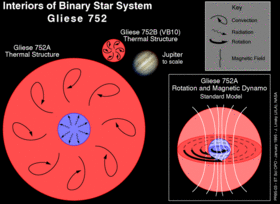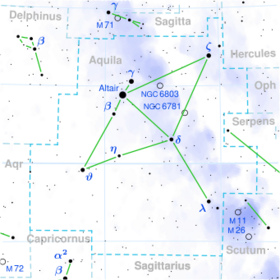Astronomy:Gliese 752
| Observation data {{#ifeq:J2000|J2000.0 (ICRS)|Epoch J2000.0 Equinox J2000.0 (ICRS)| Epoch J2000 [[Astronomy:Equinox (celestial coordinates)|Equinox J2000}} | |
|---|---|
| Constellation | Aquila |
| Gliese 752 A | |
| Right ascension | 19h 16m 55.25657s[1] |
| Declination | +05° 10′ 08.0406″[1] |
| Apparent magnitude (V) | ~9.12[2] |
| Gliese 752 B | |
| Right ascension | 19h 16m 57.61096s[3] |
| Declination | +05° 09′ 01.6009″[3] |
| Apparent magnitude (V) | ~17.30[4] |
| Characteristics | |
| Gliese 752 A | |
| Spectral type | M2.5V[2] |
| Apparent magnitude (B) | ~10.63[5] |
| Apparent magnitude (V) | ~9.13[5] |
| Apparent magnitude (R) | ~8.3[5] |
| Apparent magnitude (J) | ~5.58[5] |
| Apparent magnitude (H) | ~4.93[5] |
| Apparent magnitude (K) | ~4.67[5] |
| Variable type | BY[6] |
| Gliese 752 B | |
| Spectral type | M8V[4] |
| Apparent magnitude (B) | ~19.42[4] |
| Apparent magnitude (V) | ~17.30[4] |
| Apparent magnitude (R) | ~15.6[4] |
| Apparent magnitude (J) | 9.908 ± 0.025[4] |
| Apparent magnitude (H) | 9.226 ± 0.026[4] |
| Apparent magnitude (K) | 8.765 ± 0.022[4] |
| Variable type | UV[7] |
| Astrometry | |
| A | |
| Radial velocity (Rv) | 35.33±0.13[1] km/s |
| Proper motion (μ) | RA: −579.081[1] mas/yr Dec.: −1,332.868[1] mas/yr |
| Parallax (π) | 169.0615 ± 0.0239[1] mas |
| Distance | 19.292 ± 0.003 ly (5.9150 ± 0.0008 pc) |
| Absolute magnitude (MV) | 10.26±0.005[2] |
| B | |
| Proper motion (μ) | RA: −598.761 mas/yr Dec.: −1,366.063 mas/yr |
| Parallax (π) | 168.9537 ± 0.0668[3] mas |
| Distance | 19.304 ± 0.008 ly (5.919 ± 0.002 pc) |
| Absolute magnitude (MV) | 18.7[8] |
| Details | |
| Gliese 752 A | |
| Mass | 0.484±0.019[2] M☉ |
| Radius | 0.481±0.014[2] R☉ |
| Luminosity (bolometric) | 0.0326 ± 0.0004[9] L☉ |
| Surface gravity (log g) | 4.90±0.07[2] cgs |
| Temperature | 3,534±51[2] K |
| Metallicity | −0.04±0.16[2] |
| Rotation | 50.60±0.41 d[2] |
| Rotational velocity (v sin i) | <2[2] km/s |
| Gliese 752 B | |
| Mass | 0.0881+0.0026 −0.0024[10] M☉ |
| Radius | 0.1183+0.0059 −0.0057[10] R☉ |
| Luminosity (bolometric) | 0.000499±0.000004[10] L☉ |
| Temperature | 2,508+63 −60[10] K |
| Age | ~1[11] Gyr |
| Other designations | |
| Gliese 752 A: V1428 Aql, HD 180617, HIP 94761, Ross 652, Wolf 1055, TYC 472-1252-1, GSC 00472-01252, 2MASS J19165526+0510086[5] | |
| Gliese 752 B: VB 10, Van Biesbroeck's Star, V1298 Aql, 2MASS J19165762+0509021[4] | |
| Database references | |
| SIMBAD | A |
| VB 10 (B) | |
| Exoplanet Archive | data |
Location of Gliese 752 in the constellation Aquila | |
Gliese 752 is a binary star system in the Aquila constellation. This system is relatively nearby, at a distance of 19.3 light-years (5.9 parsecs).
The Gliese 752 system consists of two M-type stars. The primary star is the magnitude 9 Gliese (GJ) 752 A. The secondary star is the dim magnitude 17 Gliese (GJ) 752 B, more commonly referred to as VB 10. This stellar pair form a binary star system separated by about 74 arc seconds (~434 AU).[8] This system is also known for its high proper motion of about 1 arc second a year. Component A has one known exoplanet.
The name and number are from the Catalogue of Nearby Stars, published by German astronomer Wilhelm Gliese in 1969.[12]
Gliese 752 A characteristics
The primary star, also known as Wolf 1055, is a type M2.5 red dwarf with about half the size and mass as the Sun and considerably cooler at 3,534±51 K.[2] This star was first observed to be a high proper motion star by the German astronomer Max Wolf with his pioneering use of astrophotography. He added this star to his extensive catalog of such stars in 1919.[13] It is a variable star with the variable star catalog name V1428 Aquilae. It is a BY Draconis type variable star subject to flare events.[5][6]
Planetary system
In August 2018, a group of scientists using measurements taken from the CARMENES spectrograph, on the Calar Alto Observatory located in Spain, announced they had detected a planet orbiting the larger of the stars, HD 180617 (Gliese 752 A). The measurements indicated the presence of a planet with a minimum mass comparable to Neptune on an orbit partly located within the habitable zone.[9]
| Companion (in order from star) |
Mass | Semimajor axis (AU) |
Orbital period (days) |
Eccentricity | Inclination | Radius |
|---|---|---|---|---|---|---|
| b | ≥12.214±1.05 M⊕ | 0.343±0.004 | 105.911±0.109 | 0.101±0.053 | — | — |
Gliese 752 B characteristics
Gliese 752 was not known to be a binary star system until the discovery of a small dim secondary star by George Van Biesbroeck in 1944. This star is identified as VB 10 in Van Biesbroeck's star catalog. This star is notable for its very low mass. At .08 solar masses, it is near the lower mass limit for a star. It is also quite small at 10% of the solar radius.[8] A type M8V red dwarf, the star is known for its very low luminosity (one of the least luminous stars yet observed)[14] with an absolute magnitude of nearly 19, due to its very cool surface temperature of only 2600K.[4] It is a variable star with the variable star catalog name V1298 Aquilae. This star is a UV Ceti type variable star also subject to flare events. It shares the large proper motion, along with the tendency to flare, with the primary star.[7]
In 2009, the discovery of the extrasolar planet, VB 10b, was announced in orbit around this star.[11] However a subsequent spectrographic survey failed to confirm the presence of any large planets in orbit around this star.[15]
Magnetic field
In 1994, the Hubble Space Telescope observed a solar flare on Gliese 752 B. This suggests that the star has a strong magnetic field, which came as a surprise to astronomers. It had previously been assumed that low mass red dwarfs would have insignificant or nonexistent magnetic fields. These tiny dwarfs are supposed to lack the radiative zone just outside the star's core that creates the magnetic field-creating dynamos in more massive stars like our Sun. Nevertheless, the detection of solar flares indicates that as yet unknown process allows low mass stars to produce sufficient magnetic fields to power such outbursts, even if solely by convection, without a radiative core.[16]
See also
- Binary star
- List of least massive stars
References
- ↑ 1.0 1.1 1.2 1.3 1.4 Vallenari, A. et al. (2022). "Gaia Data Release 3. Summary of the content and survey properties". Astronomy & Astrophysics. doi:10.1051/0004-6361/202243940 Gaia DR3 record for this source at VizieR.
- ↑ 2.00 2.01 2.02 2.03 2.04 2.05 2.06 2.07 2.08 2.09 2.10 2.11 Burt, Jennifer; Feng, Fabo; Holden, Bradford; Mamajek, Eric E.; Huang, Chelsea X.; Rosenthal, Mickey M.; Wang, Songhu; Butler, R. Paul et al. (2021), "A Collage of Small Planets from the Lick–Carnegie Exoplanet Survey: Exploring the Super-Earth and Sub-Neptune Mass Regime", The Astronomical Journal 161 (1): 10, doi:10.3847/1538-3881/abc2d0, Bibcode: 2021AJ....161...10B
- ↑ 3.0 3.1 3.2 Vallenari, A. et al. (2022). "Gaia Data Release 3. Summary of the content and survey properties". Astronomy & Astrophysics. doi:10.1051/0004-6361/202243940 Gaia DR3 record for this source at VizieR.
- ↑ 4.0 4.1 4.2 4.3 4.4 4.5 4.6 4.7 4.8 4.9 "V* V1298 Aql". SIMBAD. Centre de données astronomiques de Strasbourg. http://simbad.u-strasbg.fr/simbad/sim-basic?Ident=V%2A+V1298+Aql.
- ↑ 5.0 5.1 5.2 5.3 5.4 5.5 5.6 5.7 "V* V1428 Aql". SIMBAD. Centre de données astronomiques de Strasbourg. http://simbad.u-strasbg.fr/simbad/sim-basic?Ident=V%2A+V1428+Aql.
- ↑ 6.0 6.1 "V1428 Aql". General Catalogue of Variable Stars, Sternberg Astronomical Institute, Moscow, Russia. http://www.sai.msu.su/groups/cluster/gcvs/cgi-bin/search.cgi?search=V1428+Aql.
- ↑ 7.0 7.1 "V1298 Aql". General Catalogue of Variable Stars, Sternberg Astronomical Institute, Moscow, Russia. http://www.sai.msu.su/groups/cluster/gcvs/cgi-bin/search.cgi?search=V1298+Aql.
- ↑ 8.0 8.1 8.2 van Biesbroeck, G. (August 1944). "The star of lowest known luminosity". The Astronomical Journal 51: 61–62. doi:10.1086/105801. Bibcode: 1944AJ.....51...61V. http://articles.adsabs.harvard.edu/full/seri/AJ.../0051//0000061.000.html?high=49ee8336c004367.
- ↑ 9.0 9.1 Kaminski, Adrian et al. (3 August 2018). "The CARMENES search for exoplanets around M dwarfs. A Neptune-mass planet traversing the habitable zone around HD 180617". Astronomy & Astrophysics 618: A115. doi:10.1051/0004-6361/201833354. Bibcode: 2018A&A...618A.115K.
- ↑ 10.0 10.1 10.2 10.3 Pineda, J. Sebastian; Youngblood, Allison; France, Kevin (September 2021). "The M-dwarf Ultraviolet Spectroscopic Sample. I. Determining Stellar Parameters for Field Stars". The Astrophysical Journal 918 (1): 23. doi:10.3847/1538-4357/ac0aea. 40. Bibcode: 2021ApJ...918...40P.
- ↑ 11.0 11.1 Pravdo, Steven H.; Shaklan, Stuart B. (June 2009). "An Ultracool Star's Candidate Planet". The Astrophysical Journal 700 (1): 623–632. doi:10.1088/0004-637X/700/1/623. Bibcode: 2009ApJ...700..623P. http://steps.jpl.nasa.gov/links/docs/pravdoshaklan09vb10b.pdf. Retrieved 2009-05-30.
- ↑ Gliese, W. (1969). "Catalogue of Nearby Stars. Edition 1969". Veröffentlichungen des Astronomischen Rechen-Instituts Heidelberg. 22 (Karlsruhe: G. Braun) 22: 117. Bibcode: 1969VeARI..22....1G. http://www.ari.uni-heidelberg.de/publikationen/vhd/vhd022/fulltext/gif.c001.htm. Retrieved 2011-05-11.
- ↑ Wolf, M. (August 1919). "Starkbewegter Stern in Aquila". Astronomische Nachrichten 209 (4): 61–62. doi:10.1002/asna.19192090406. Bibcode: 1919AN....209...61W. https://zenodo.org/record/1424922.
- ↑ Probst, R. G.; Liebert, J. (1983-11-01). "LHS 2924 : A uniquely cool low-luminosity star with a peculiar energy distribution.". The Astrophysical Journal 274: 245–251. doi:10.1086/161442. ISSN 0004-637X. Bibcode: 1983ApJ...274..245P. https://ui.adsabs.harvard.edu/abs/1983ApJ...274..245P.
- ↑ Bean, Jacob L.; Seifahrt, Andreas; Hartman, Henrik; Nilsson, Hampus; Reiners, Ansgar; Dreizler, Stefan; Henry, Todd J.; Wiedemann, Guenter (2009). "The CRIRES Search for Planets Around the Lowest-Mass Stars. II. No Giant Planet Orbiting VB10". arXiv:0912.0003v1 [astro-ph.EP].
- ↑ "Red Dwarf Dynamo Raises Puzzle over Interiors of Lowest Mass Stars". hubblesite. 1995-01-10. http://hubblesite.org/newscenter/archive/releases/1995/03/text/.
Coordinates: ![]() 19h 16m 58s, +05° 09′ 02″
19h 16m 58s, +05° 09′ 02″
 |



